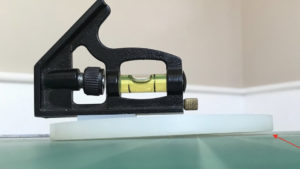Why Calling Out Flat Surfaces On Your CNC Machined Part Matters
Are you working on a prototype model that’s flat on one or more sides? Whether you’re transitioning a prototype from an injection mold to CNC machining or creating a proof of concept for fit and function, if your model has a flat surface, there are a few things you should know before machining.
Flat surfaces are likely to bow if stress is introduced on one side but not the other. Think of a board with only one painted side. As the paint dries, added stress from the paint pulls one side of the board up toward the paint, causing it to arc.
This same concept applies to machining. Your model may appear to be perfectly flat, but that doesn’t mean your machined part will be. If you haven’t taken the proper precautions to call out flatness in the design, your part could bow, which costs time and money to fix.
Why Do Flat Surfaces Bow During CNC Machining?
Machining can cause flat surfaces to bow for a couple reasons:

- Heat. If you put a tortilla in a hot cast iron pan, it will expand and shift dimensions: the heat causes it to change shape. Machining is certainly more complex than cooking a tortilla, but the idea is similar. Machining applies heat to a part. Then, once the part cools, stress can create bowing on any given side.
- Material removal. If you cut the top off a soda can, the can will change shape. The rim alone can’t maintain the integrity of the cylindrical can. That’s because removing material changes the shape of a part. In machining, you may have one relatively flat side of a part while the other side has sections of removed material. Those gutted sections reduce stress on that side, causing the other flat side to buckle.
We have proven experience machining flat surfaces and know how to maintain flatness despite these obstacles.
How Materials Affect the Flatness of a Prototype
Our approach to maintaining flatness starts with considering the materials we’re using. Different materials have specific chemical properties that determine their stability—in other words, how likely they are to bow.
But don’t assume that the hardest materials are the most stable. Sometimes the toughest materials, like aluminum and steel, are the most vulnerable to bowing!
Maintaining flatness is easy enough with materials like acrylonitrile butadiene styrene (ABS) and fiberglass (a reliably stable material due to the many fibers that keep it straight). But materials like nylon, plastics, and Delrin require significant effort to maintain flatness, which can affect cost and lead time.
At KAD, we can work with all of these materials, regardless of their relative stability.
In addition to knowing the requirements of various materials, we maintain flat surfaces by increasing the amount of the material we work with when we start machining.
Sometimes clients are tempted to reduce machining costs by requesting the minimum amount of material necessary for their prototype. But if you need to maintain flatness, you’ll actually need more material!
To obtain flatness, we’ll start with more material thickness than is ultimately needed. That leaves enough room to cut the part down and ensure that the stresses are equal on all sides. We machine the part until it’s nearly complete, then do a final pass over it to make it flat.
Prevent Bowing from the Start
We can fix machined prototypes that have bowed, but that costs time and money. The best way to prevent bowing is to call out flatness in your prototype model from the very beginning so that we can adjust our approach accordingly.
Your drawing may appear to be flat, but if you haven’t explicitly specified flatness, you run the risk of a crooked model or tolerances that may not work for your part.
You can call out flatness on one side or multiple sides of your part design. If your part will connect to another part or parts with fasteners (in an assembly), you may also want to indicate that the part needs “flatness while constrained”.
If any side of your part needs to be flat, let us know! Send us an email to accompany your quote or leave the callout in print on your model. At KAD, we pride ourselves on communication, and want to know all the nuanced details of your part so we can machine the best possible prototype for you.
Request a quote to get the ball rolling for your next project!



